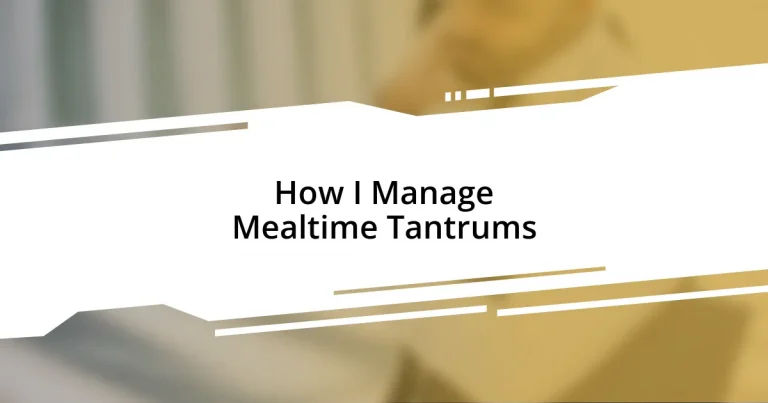Key takeaways:
- Mealtime tantrums often stem from emotional factors such as fatigue, social dynamics, and unfamiliar foods, requiring parents to be attentive to their child’s cues.
- Establishing a consistent routine, involving children in meal preparation, and offering choices can help prevent tantrums and create a positive mealtime atmosphere.
- Effective communication, such as validating emotions and using positive reinforcement, encourages children to express their feelings and fosters cooperation during meals.
- If tantrums persist despite employing these strategies, seeking professional help may be necessary to address underlying issues impacting the child’s relationship with food.

Understanding Mealtime Tantrums
Mealtime tantrums can often feel like a mystery wrapped in frustration. I remember a particularly chaotic dinner when my little one, usually a good eater, suddenly transformed into a whirlwind of tears and refusal. What triggered that outburst? Was it the broccoli I had served or just the stress of the day? Understanding the reasons behind these tantrums requires a look not just at the food on the plate, but also at the emotional context surrounding mealtimes.
It’s essential to recognize that toddlers have their own ways of expressing feelings and desires. In my experience, hunger can turn into anger or sadness in mere moments. There have been times when my child would act out, not because they disliked the food, but because they were feeling tired or overstimulated. Isn’t it fascinating how something as simple as a meal can unearth a whirlwind of emotions?
Each child is unique, and what may trigger a tantrum for one might not for another. This variability forces us to adapt and pay close attention to our child’s cues. For instance, keeping a consistent routine around meals can create a sense of security. I’ve found that when we set the table at the same time each day, it often helps reduce the uncertainty that can lead to those dramatic outbursts.

Common Triggers for Tantrums
It’s interesting to observe how specific situations can lead to tantrums at mealtime. One common trigger I’ve noticed is fatigue. I recall a night when we found ourselves at the dinner table, and my child, who had been bouncing off the walls just an hour earlier, suddenly lost all interest in eating. After a bit of probing, it became clear my little one was simply too tired to focus on anything but sleep. Recognizing this has taught me that sometimes it’s best to adjust mealtime around their energy levels rather than push for structured eating times.
Another prevalent trigger stems from social dynamics. When we have friends over or are in a busy environment, the excitement can become overwhelming for my little one. I remember hosting a dinner party where my child quickly felt lost in the shuffle of conversations and laughter. Instead of delighting in the meal, my child ended up having a meltdown that echoed through the entire kitchen! Since then, I’ve learned to prepare quieter mealtimes when the social scene is high to keep those emotions in check.
Lastly, specific food choices can ignite emotional responses, even if they seem harmless. I had a moment when I served a dish with a new ingredient; the moment the food hit the plate, my child’s eyes widened in horror, leading to an epic meltdown. In hindsight, it was simply a reaction to the unforeseen. This experience underscored the importance of introducing new foods gradually and maintaining a steady base of familiar favorites.
| Common Trigger | Example |
|---|---|
| Fatigue | Tired child refuses to eat, wanting to sleep instead. |
| Social Dynamics | Overstimulation when guests are over leads to tantrums. |
| Unfamiliar Foods | Child reacts negatively to a new dish, causing an outburst. |

Strategies for Preventing Tantrums
Preventing mealtime tantrums calls for some proactive strategies that address not just the food, but the entire atmosphere surrounding meals. One approach that has worked wonders for me is to involve my child in the meal preparation process. I remember one evening when my little helper eagerly stirred the pot; the excitement translated into a better reception of the dinner. Letting them choose between a couple of healthy options also fosters a sense of control that can ease anxiety.
Here are some strategies I’ve found effective in preventing those pesky tantrums:
- Routine is Key: Establishing consistent mealtimes helped my child anticipate what’s next, reducing anxiety.
- Involvement: Invite your child to help with meal prep, making them feel connected to the food.
- Offer Choices: Presenting two options can give a sense of control, steering clear of resistance.
- Mind the Environment: Create a calm setting, minimizing distractions or overstimulation.
- Preempt Hunger: A small, healthy snack before meals can stave off hunger-induced crankiness.
By embracing these strategies, I’ve seen a noticeable reduction in tantrums, transforming mealtimes from chaos into a more enjoyable family experience.

Effective Communication Techniques
Effective communication during mealtime can be a game changer in managing tantrums. I remember a time when my child threw a fit about not wanting broccoli. Instead of getting frustrated, I knelt down to their level and asked, “What makes you feel this way about broccoli?” The simple act of opening a dialogue not only diffused the situation but also led to my child expressing their dislike without feeling judged. It showed me that asking questions can encourage kids to share their feelings, which ultimately leads to better understanding.
I also found that validating their emotions plays a crucial role. One night, my little one was visibly upset because the pasta was too saucy for their taste. Instead of dismissing their feelings, I gently acknowledged, “I see you’re not happy with the sauce. It can be overwhelming sometimes.” This approach helped them feel heard, and we were able to talk about how to adjust their portion without tears and tantrums. When children feel understood, they’re more likely to cooperate.
Lastly, using positive reinforcement can work wonders too. After a dinner where my child surprised me by trying a new vegetable, we celebrated by drawing a happy face on the meal chart we keep in the kitchen. I saw their eyes light up with pride, and it created a sense of accomplishment. So, how can we use positive moments to build better habits at the dinner table? I believe it’s about creating a cycle of encouragement—where trying new foods becomes a shared adventure rather than a battleground.

Creating a Positive Mealtime Environment
Creating a positive mealtime environment can really set the tone for a stress-free dining experience. I remember one evening when I dimmed the lights a bit and played soft music while we ate. My child, usually a ball of energy during meals, seemed to relax and even savored each bite. It’s incredible how an inviting atmosphere can shift everyone’s mood and spark a little joy around the dinner table.
I’ve also found that decorating our table with simple seasonal elements can make mealtimes feel special. One time, I brought out some colorful autumn leaves and placed them around our dinner plates. We ended up discussing our favorite fall activities while we ate, which not only distracted from any potential disagreements over food but also fostered connection. How often do we consider the impact of a few thoughtful touches on our dining experience? I believe these little details can transform an ordinary meal into a cherished family moment.
Another game changer for me has been allowing my child to set the table. They get excited choosing the utensils or folding napkins in fun shapes. I’ve noticed that when they have a role in the setup, they’re far more enthusiastic when it’s time to eat. The question I often ponder is, why not empower our children in these small ways? Involving them in the mealtime routine fosters ownership and pride, making them more likely to engage positively with the food.

When to Seek Professional Help
Sometimes, it becomes clear that the strategies we’ve tried just aren’t working. If tantrums escalate in intensity or frequency despite our best efforts, it may be time to seek professional help. I’ve had moments where, despite all the communication and positive experiences at the table, my child still reacted explosively over what seemed like any minor food change. Those experiences made me realize that some underlying issues might be at play.
I often wondered if I was missing something deeper. Have you ever felt like you’re navigating your child’s emotions without a map? If mealtime struggles start affecting family dynamics, social interactions, or your child’s overall mood, a pediatrician or child psychologist can provide insights tailored to your unique situation. Seeking expert advice isn’t a sign of failure; rather, it’s an empowering step to ensure that both you and your child thrive, not just survive, during meals.
Occasionally, it’s essential to trust our instincts as parents. If you notice your child displaying unusual signs of anxiety or fear around food that seem disproportionate to the situation, that’s a clear signal to reach out for help. I distinctly recall a time when my little one would just freeze at the sight of certain vegetables. Recognizing these moments can lead to early intervention, potentially easing food-related stress for everyone involved. Isn’t it worth exploring every option to create a calm and joyful dining experience?

Long-Term Solutions for Tantrums
Long-term solutions for mealtime tantrums often revolve around consistent routines and open communication. I’ve found that sticking to a regular meal schedule can bring a sense of stability to my child’s eating habits. There was a week when we tried having dinner at the same time each night, and I was amazed to see how my child’s anxiety around meals diminished significantly. Isn’t it fascinating how something as simple as timing can create a sense of security?
Another approach that truly resonates with me is involving my child in meal planning. I remember a time when I sat down with my little one and made a fun menu together. They were thrilled to choose what meals we would have that week, and, surprisingly, when it came to dinner time, they were much more willing to try new dishes. This collaboration not only strengthened our bond but also made mealtime feel less like an obligation and more like a shared adventure. Have you ever considered how empowering children in decision-making can transform their willingness to engage?
Finally, modeling positive eating behaviors is critical. I recall a dinner where I intentionally shared my excitement over a new healthy recipe. My enthusiasm must have been contagious because my child eagerly tried it without fussing. It illustrates the power of leading by example; when I enjoy my food, they tend to mirror that joy. Isn’t it interesting how our attitudes toward food can influence their perceptions? In the journey of nurturing a healthy relationship with food, I think it’s essential to remember that our actions often speak louder than words.














